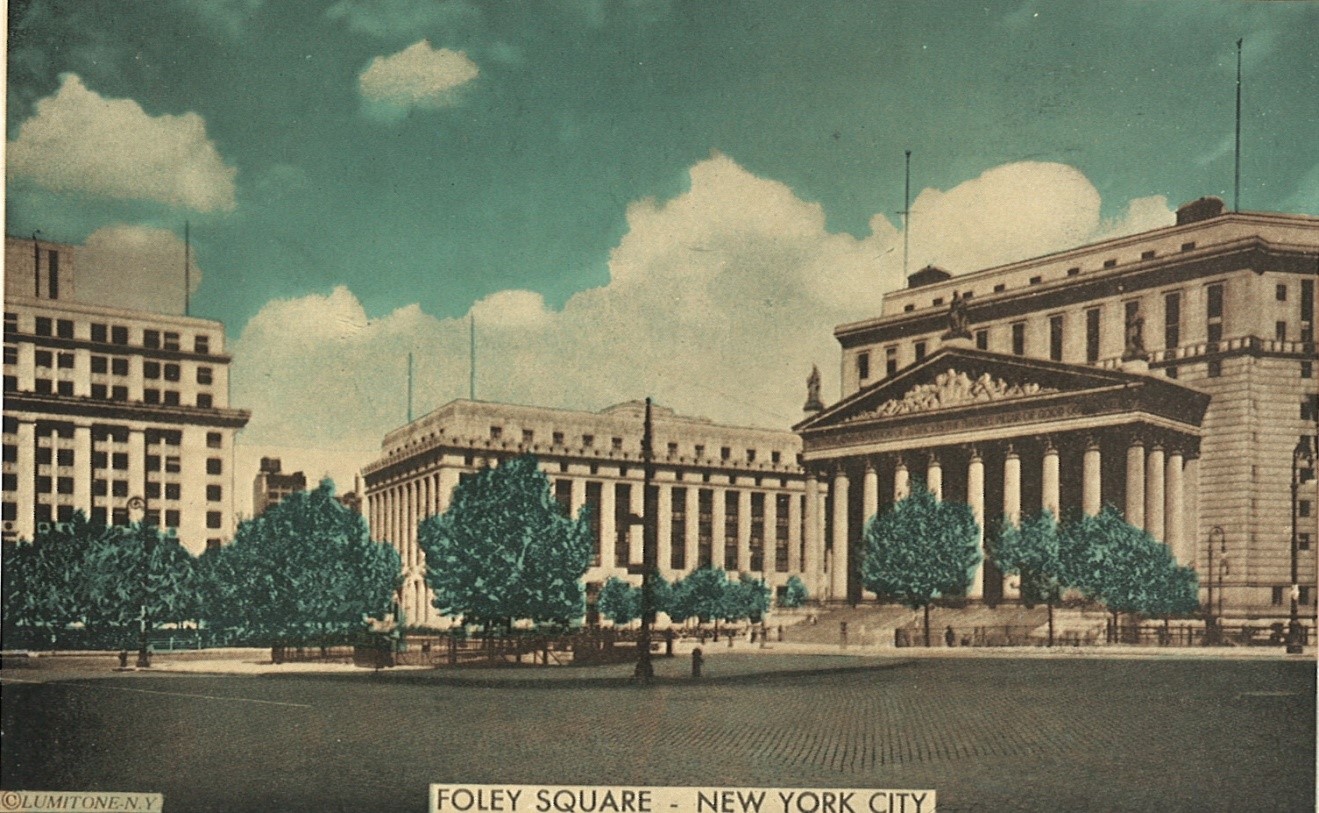This blog entry was written by John Caher, the Unified Court System’s senior advisor for strategic and technical communications. It discusses his recent interview with Robert Pigott about The Historical Society of the New York Courts’ upcoming program History of Foley Square: NY Legal Landmarks & Civic Reform on Feb. 27 at 6:30 PM at the NYC Bar Association. The interview was converted into an “Amici” Podcast, one of a series produced by the court system and maintained at http://www.nycourts.gov/admin/amici/index.shtml.
Photo: Foley Square Postcard, July 1939
How wonderfully ironic and deliciously tantalizing that Foley Square – the center of justice in New York City – is named for a Tammany Hall saloon keeper! As they say, only in New York.
From its colorful founding to its present-day prestige, Foley Square, home to a slew of federal, state and local court facilities, is the set and stage for all manner of real and fictional drama, from the espionage trial of Julius and Ethel Rosenberg to the custody trial of Gloria Vanderbilt to a gruesome assassination scene in The Godfather. It was even a triage center on 9/11.
Thomas F. “Big Tom” Foley died in 1925 and never had an opportunity to see what his namesake would become. If there’s an afterworld, and a bookstore in it, he’d do well to check out attorney Robert Pigott’s book, New York Legal Landmarks: A Guide to Legal Edifices, Institutions, Lore, History and Curiosity on the City Streets.
Pigott, vice president and general counsel of Phipps Houses, shared his knowledge of Foley Square in a recent interview with the Unified Court System’s podcast program, Amici. He’ll do the same Feb. 27 at an event sponsored by The Historical Society of the New York Courts — History of Foley Square: New York Legal Landmarks & Civic Reform.
The 6:30 PM program at the New York City Bar Association will also feature: Court of Appeals Judge (Ret.) Albert M. Rosenblatt, president of the Historical Society; Jon Ritter, a clinical associate professor at NYU; Charles Starks, an adjunct lecturer in urban planning and policy at Hunter College and CUNY; and a panel discussion including Hon. Dennis Jacobs, former Chief Judge of the Second Circuit U.S. Court of Appeals.
A former section chief in the New York Attorney General’s Charities Bureau, Pigott was on what he calls a “discover Brooklyn kick” about five years ago when he stumbled on a majestic building with two entrances, one labeled “Magistrates Court” and the other labeled “Municipal Court” — courts he’d never heard of in 25 years of practice in the City. That led him to begin poking into the history of court facilities, and as a pulled on more and more threads he inevitably ended up at Foley Square.
“It really is the epicenter of all legal and judicial activity in New York City,” Pigott told Amici, referring to Foley Square. “In some of the outer boroughs, there are centers like Court Street in Brooklyn, or the St. George Terrace area in Staten Island, and you do have clusters of courthouses and government buildings, but it really can’t compare to Foley Square, either in terms of the buildings, or what happens inside those buildings.”
Pigott’s topic on Feb. 27th is, “From City Hall to Foley Square: Government Buildings Take a Step Uptown.” It will set the stage for the migration of court buildings from City Hall Park to Foley Square. Ritter will follow with “Drawing Circles and Hexagons Around the Square: The NY Civic Center and Progressive-Era Reform in the U.S.” This talk will describe how the creation of Foley Square fits into the national reform movement of the era. Starks will focus on “Pioneering City Planning in the Heart of NY: George McAneny, Rapid Transit, Zoning and the Civic Center.” George McAneny was an important city planner who played a critical role in the development of this civic center. Then, all the presenters will join Judge Jacobs in a panel discussion moderated by Judge Rosenblatt.
Listen to the entire interview, available here and in the iTunes podcast library. A transcript of the interview can be found here.

